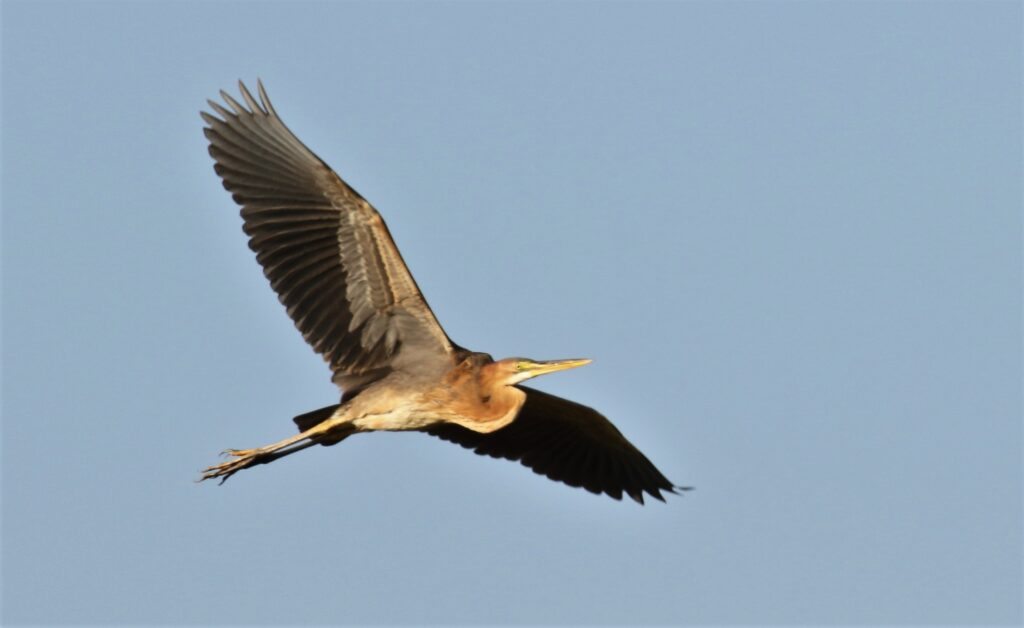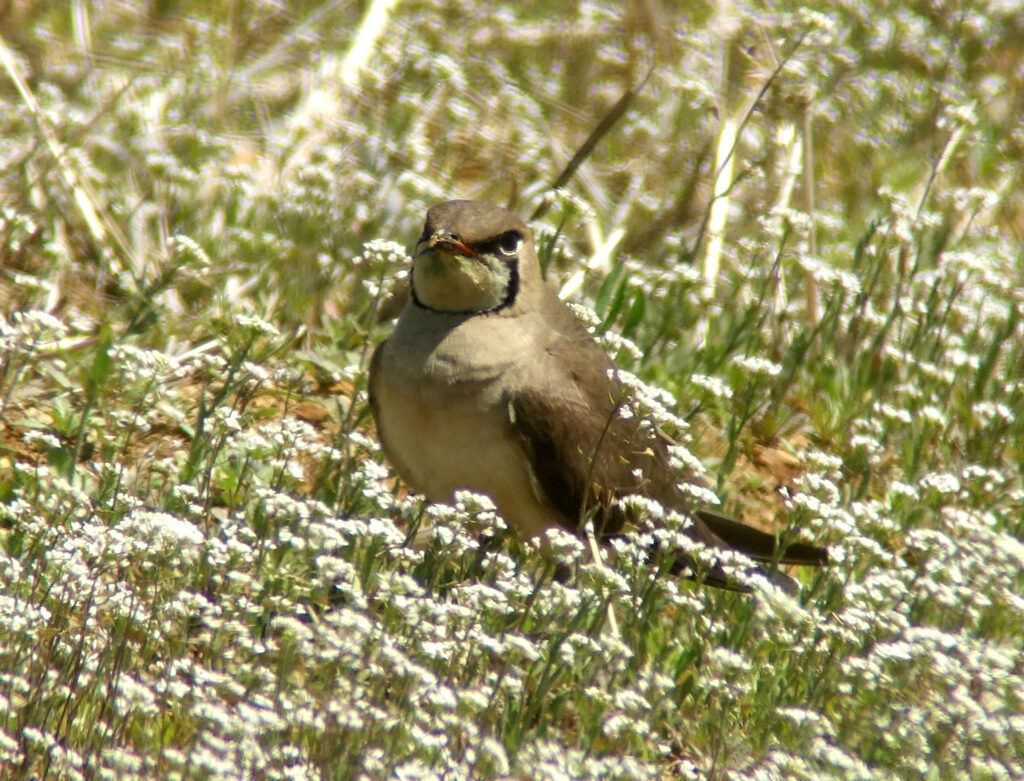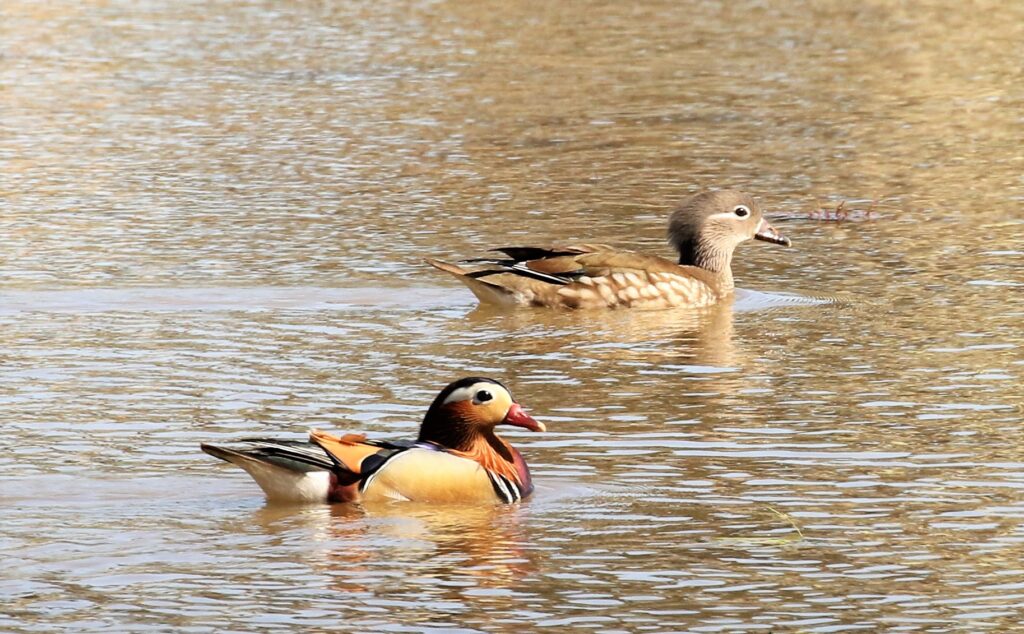Bird news from Subhojit Chakladar (with Prof Todd Hull and Dr Nial Moores)
A week long birding trip to perhaps the best birding spot in Korea during the peak of the spring migration can be an overwhelming experience! Baekryeongdo lived up to its reputation in terms of producing both stunning diversity as well as the number of birds. However, it was also accompanied by unparalleled drama which demands a post of its own 🙂
In all SC and TH observed 185 species during nine days of birding, including several rarities and two national firsts! There were times when the air was thick with yellow dust with very few birds but at other times we could only stare in awe at “clouds of hirundines” and “fields overflowing with snipes and buntings”. This trip allowed TH to finally connect with 2 of his bogey birds, produced 3 phyllosc lifers for SC (within an hour) and even provided NM with a lifer! A day by day account of a memorable trip by SC and TH, together with NM (on the island since mid-April) from the evening of May 3rd…
May 1
From the ferry, a handful of Streaked Shearwater and at least three whales (of unidentified species) were seen by SC. Once on the island, SC and TH explored a few different types of habitats for approx 6 hours primarily covering the northern section of the island. Species of note included 2 Garganey, 2 Chinese Egret, 7 Black-faced Spoonbill. As is typical for early spring, there were quite a few different species of buntings (7 species) and warblers (4 species of Phylloscopus warblers). The weather was sunny with winds mostly from the south.




The full checklist for the day on eBird: May 1st checklist
May 2
With winds swinging towards south-west, we set out with high hopes. It was a bright, cloudless day and we spent around 13 hours in the field. First highlight of the day came in form of flocks of snipes (many of them in flight including at least 2 and possibly as many as 4 species). We also saw the 1st Pacific Golden Plover of the trip, 2 cracking male Amur Falcon and a Purple Heron. In the main wetland area, there were quite a few species of shorebirds including 2 Spotted Redshank, 1 Sharp-tailed Sandpiper, 3 Long-toed Stint, 2 Red-necked Stint, 12 Black-winged Stilt and 1 Bar-tailed Godwit (apparently a first for the island!). There were large numbers of Eastern Yellow Wagtail. 3 sub-species were present in the same location allowing us to compare the differences in their plumage. Other birds of note included 2 Cirtrine Wagtail, 3 Oriental Pratincole, 15 Pacific Swift. Towards the end of the day, a Latham’s Snipe was found.






May 3
Another 13 hour day in the field and 84 species observed. New birds for trip were 37 Common Shelduck, 10 Northern Shoveler, 2 Eurasian Wigeon, 2 Oriental Cuckoo (heard only), 3 Chinese Pond Heron, 1 Striated Heron, 2 Black-naped Oriole, 1 Eurasian Wryneck, 1 Oriental Scops Owl (heard only), 2 Azure-winged Magpie, 8 Radde’s Warbler, 8 Chestnut-cheeked Starling, 1 White-shouldered Starling, 2 Rufous-tailed Robin (more heard), 2 Siberian Blue Robin, 1 Narcissus Flycatcher, 1 Mugamaki Flycatcher, 1 Red-breasted Flycatcher, 2 Common Rosefinch, 1 Hawfinch, 4 Chinese Grosbeak. Towards the end of the day, clouds rolled in.


The full checklist of the day on eBird: May 3rd checklist
May 4
Delayed start due to heavy rain at dawn but what a day!! A lot of the birding was done from the car during the rain or close to the car in between showers. From the start there was evidence of large scale movement and it got more and more spectacular as the day progressed, with first dozens of shorebirds, then a flock of 30 Eyebrowed Thrush, with a decent sized flock of Ashy Minivet also observed in the area. The undoubted highlight of the day came early in the form of a Eurasian Crag Martin (fewer than 10 national records?). The bird was initially spotted by NM and then seen well and photographed by both SC and TH. It was even seen resting on the ledge of a rock face (which was christened as THE CRAG) allowing extended scope views.


New birds for the trip included 1 Falcated Duck, 1 Mallard, 8 Eurasian Teal, 1 Grey Plover, 3 Lesser Sand Plover, 1 Kentish Plover, 1 Whimbrel, 4 Green Sandpiper, 2 Grey-tailed Tattler, 1 Black-capped Kingfisher, 1 Oriental Reed Warbler, 1 Sakhalin Leaf warbler (heard and sonogram analyzed), 5 Long-tailed Tit, 1 Red-flanked Bluetail, 6 Red-throated Pipit, 2 Pallas’ Reed Bunting, 1 Yellow-breasted Bunting, 1 Rustic Bunting.
But more than the diversity of species, the sheer number of certain species made the day an overwhelming experience. Species like Wood Sandpiper (conservative count of 300), Long-toed Stint (approx 75 in a small area), dozens of snipes (of various species), Eyebrowed Thrush (at least 130), Eastern Yellow Wagtail (approx 120), Little Bunting (approx 120), Yellow-browed Bunting (approx 200), Black-faced Bunting (approx 700), Olive-backed Pipit (at least 400), Red-rumped Swallow (approx 2500), Barn Swallow (at least 5000) were present in numbers that left us awestruck at times. A total of 114 species were logged on this day.


The full checklist of the day on eBird: May 4th checklist
May 5
The rain was replaced by high winds from the south and south-west. Better weather meant we could bird much longer (it was a 14 hour day). We logged a total of 124 species, including a presumed Yellowhammer seen very briefly in flight by both NM and TH: a large, bulky, long-tailed bunting with bright yellow head and browner ear coverts, bright yellow underparts, and brown upperparts with a contrasting rusty-rufous rump, flushed by a passing Pied Harrier and three alarmed Oriental Pratincoles!
New trip species on this day included a pair of Mandarin Duck, 1 Common Pochard, 5 Tufted Duck, 10 Stejneger’s Scoter, 1 White-throated Needletail, 2 Temminck’s Stint, 1 Lesser Black-backed Gull, 1 Arctic Loon (Black-throated Diver), 1 Eurasian Spoonbill, 2 Pied Harrier, 5 Japanese Sparrowhawk, 3 Eurasian Hobby, 1 Yellow-bellied Tit, 3 Chinese Penduline Tit, 2 Swinhoe’s White-eye, 2 Daurian Starling, 1 Grey Thrush (Japanese Thrush), 1 Siberian Rubythroat, 2 Japanese Waxwing, 3 Forest Wagtail and 1 Little Curlew (TH’s long time bogey bird).









The full checklist of the day on eBird: May 5th checklist
May 6
With winds getting stronger, birding became more difficult. We still managed to clock 107 species on this day.
Highlights of the day included 2 Northern Hawk Cuckoo (heard distantly), 7 Pacific Golden Plover, 2 Curlew Sandpiper (first record on the island known to Birds Korea), 1 Chinese Sparrowhawk, 2 Oriental Dollarbird, 40 Chestnut-flanked White-eye.




The full checklist of the day on eBird: May 6th checklist
May 7
With thick yellow dust blanketing the island, it was the most difficult birding day on the island. We only managed to see 84 species this day.
Highlight of the day was a Rufous-bellied Woodpecker (TH’s other bogey bird). Scanning through hirundine flocks over the main reservoir, we saw one tylteri type Barn Swallow, and also counted about 30 Sand Martin and 1 lagopodum Common House Martin (soon to be split as “Siberian House Martin” by the IOC).

The full checklist of the day on eBird: May 7th checklist
May 8
The last full day on the island, coinciding with Global Big Bird Day coordinated by eBird to help celebrate World Migratory Bird Day. With yellow dust clearing and winds subsiding then switching from SW to NW, birds were beginning to get active once again. The increase in numbers was also accompanied by an increase in diversity. We logged 111 species on this day but more than the number of species, this day was special for the TWO (!) national firsts that were recorded and the drama involved!
Starting very early, we came across 1 (or possibly even 2) Rufous-bellied Woodpecker. The next highlight of the day came in the form of a striking looking “golden-spectacled” Phylloscopus warbler which was only seen by NM. “Golden-spectacled warbler” is the collective name given to the group of three or four near-identical looking species, formerly contained within Seicercus, which when out of range can only reliably be identified through their vocalisations. None have been claimed in Korea before. SC and TH walking about a 100m ahead, failed to see the bird (on that day). As we were leaving, after an extended search and wait of about 2.5hrs, NM then heard and glimpsed an apparent Orange-headed Thursh. In the southwest of the island, we heard the first Common Cuckoo of the season. Closer to sunset came the second massive highlight of the day in form of a Grey-backed Shrike. Initially seen by NM only, the bird went into a forested slope in a mine-field before being relocated by SC about 20 mins later. All 3 of us got great views of the bird after that as he / she sat perched in the open for next 10 mins or more looking towards the sun (presumably trying to figure out the direction in which to migrate next).



The full checklist of the day on eBird: May 8th checklist
May 9
Starting early, we staked out the area where the unknown “golden-spectacled warbler” was seen the previous day. There were a lot of warblers all around but our target was nowhere to be seen. After a patient wait of about 2 hours, SC finally spotted the bird close by in the undergrowth. NM and TH soon joined in the sighting. NM sound recorded the species while SC and TH managed to get some record shots.
Based on the images, on the analysis of the sonogram of the call and on the expert comments of Paul Holt and Prof. Per Alstrom, the warbler has been confirmed as a Martens’s Warbler Phylloscopus omeiensis.

While waiting for this bird, SC also spotted a Yellow-streaked Warbler. A few hundred meters away, a second Yellow-Streaked was heard calling by NM and was then seen by all 3 of us about an hour later. Under bright blue skies and soaring spirits, we came across yet another (!) highlight in form of a very obliging Alpine Leaf Warbler – in the same field!
Additional new birds for the trip on this half-day included a Chinese Blackbird and a singing Pine Bunting.


The full checklist of the day on eBird: May 9th checklist
With the additions from this trip, the Baekryeong Island checklist now stands at approximately 373.
